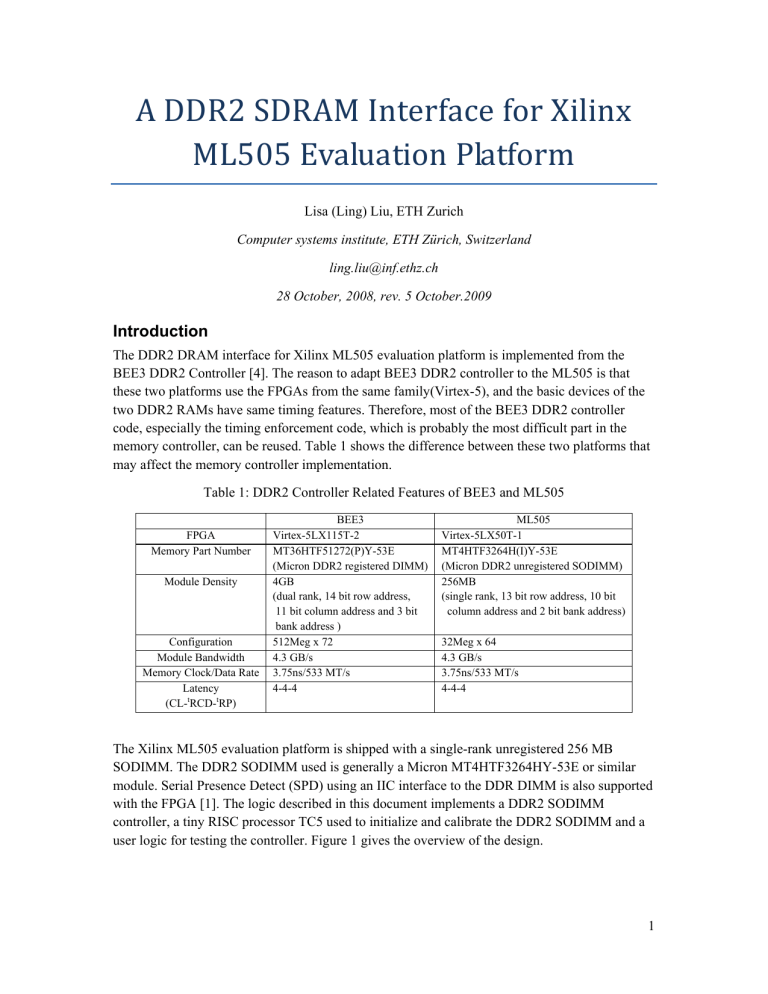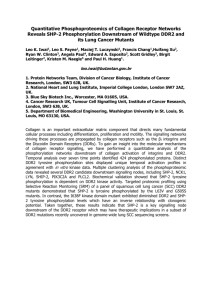A DDR2 SDRAM Interface for Xilinx ML505 - ETH E

A DDR2 SDRAM Interface for Xilinx
ML505 Evaluation Platform
Lisa (Ling) Liu, ETH Zurich
Computer systems institute, ETH Zürich, Switzerland ling.liu@inf.ethz.ch
28 October, 2008, rev. 5 October.2009
Introduction
The DDR2 DRAM interface for Xilinx ML505 evaluation platform is implemented from the
BEE3 DDR2 Controller [4]. The reason to adapt BEE3 DDR2 controller to the ML505 is that these two platforms use the FPGAs from the same family(Virtex-5), and the basic devices of the two DDR2 RAMs have same timing features. Therefore, most of the BEE3 DDR2 controller code, especially the timing enforcement code, which is probably the most difficult part in the memory controller, can be reused. Table 1 shows the difference between these two platforms that may affect the memory controller implementation.
Table 1: DDR2 Controller Related Features of BEE3 and ML505
BEE3 ML505
FPGA Virtex-5LX115T-2
Memory Part Number MT36HTF51272(P)Y-53E
(Micron DDR2 registered DIMM)
Module Density
Configuration
Module Bandwidth
4GB
(dual rank, 14 bit row address,
11 bit column address and 3 bit
bank address )
512Meg x 72
4.3 GB/s
Virtex-5LX50T-1
MT4HTF3264H(I)Y-53E
(Micron DDR2 unregistered SODIMM)
256MB
(single rank, 13 bit row address, 10 bit
column address and 2 bit bank address)
32Meg x 64
4.3 GB/s
Memory Clock/Data Rate 3.75ns/533 MT/s
Latency
(CLt
RCDt
RP)
3.75ns/533 MT/s
4-4-4 4-4-4
The Xilinx ML505 evaluation platform is shipped with a single-rank unregistered 256 MB
SODIMM. The DDR2 SODIMM used is generally a Micron MT4HTF3264HY-53E or similar module. Serial Presence Detect (SPD) using an IIC interface to the DDR DIMM is also supported with the FPGA [1]. The logic described in this document implements a DDR2 SODIMM controller, a tiny RISC processor TC5 used to initialize and calibrate the DDR2 SODIMM and a user logic for testing the controller. Figure 1 gives the overview of the design.
1
Figure1: DDR2 SDRAM Interface Block Diagram
The DDR2 memory interface consists of TC5 and DDR2 controller. TC5 ("Tiny Computer v5") is responsible for initializing, refreshing the DDR2 RAMs and calibrating the data pins. It also starts and monitors the tester.
The DDR2 controller provides three FIFOs that exchange address and control, read data and write data between the controller and the tester (user logic). Each unit of the Address FIFO AF stores the address and the read/write command from the tester. The address is 23 bits in length. This is the address of a 32 byte quantity, so the overall address space is 256MB. The address is companied by a single bit indicating whether the operation is a Read (1) or a Write (0). The data width of the write data FIFO WB is 128 bits, which is same as the width of the data path of the user logic. The user logic supplies two 128 bit words for each write. Commands are processed in order, and read data is supplied in the order that the addresses were supplied. The read data FIFO
RB is 128 bit wide. For each read, the user logic extracts two 128 bit words from RB. The I/O ports of the DDR2 controller are connected to the pins of the DDR2 SODIMM.
The rest of this document lists the modified places in the BEE3 DDR2 controller. The paragraph organization follows the order in [4].
2
DDR2 Controller Interface
Table 2 shows the changed places in the DDR2 controller interface and the reasons for these changes.
Signal Name BEE3
Definition
Table 2: Changed Controller Interface Signals
ML505 Definition Reason
LastALU[33:0] LastALU[28:0] LastALU
(from TC5)
DQ
DOS,
DQS_L
A
BA
RS
DQ[71:0]
DQS[17:0]
DQS_L[17:0]
A[13:0]
BA[2:0]
RS[3:0]
ODT ODT[1:0]
DIMMreset DIMMreset
KillRank3
(from TC5)
KillRank3
DQ[63:0]
DQS[7:0]
DQS_L[7:0]
A[12:0]
BA[1:0] no definition
ODT no definition defined in Top module
13(row address) + 8(column address of the block) + 2(bank address) = 23
3 (cmd) + 3(altCmd) + 13 (addr) + altAddr(8) + bank(2) =
29
64 DQ signals
8 DQS signals
13 bit row address
2 bit bank address, 4 banks single rank DDR2 SODIMM one bit ODT no reset signal no rank3, this signal is connected to the chipselect signal in Top module
Controller Module
The hierarchy of the controller Verilog is same as the BEE3 DDR2 Controller.
Controller Implementation
The controller data and address path is shown in Figure 2.
3
CLK Domain
MCLK Domain
Address[22:0],
Read
Address FIFO
(1 BRAM)
AFfull
WriteAF
AFclock CLK
TC5 LastALU[28:0]
InjectTC5address
Register
Normal
Alt
CLK
CLK
Register d1
Register d2 numOps
MCLK
Open
Bank
Logic
Timing Limit
Enforcement stall
Address, Command to SODIMM
WriteData[127:0]
Write Data FIFO
(2 BRAM)
WD[127:0]
128h’aaa...
WBfull
WriteWB
WBclock
ReadWB
MCLK90
MCLK90
Register Register
DRAM
SODIMM
DQ[63:0]
ISERDES
~MCLK
Register
RBfull
WriteRB
MCLK90
Read Data FIFO
(2 BRAM)
ReadData[127:0]
RBempty
ReadRB
RBclock
Figure 2: DDR2 Controller
The difference between the BEE3 and ML505 DDR2 controllers is that the FIFOs are implemented with Block RAMs without ECC. Because the DDR2 SODIMM only has 64 bit DQ signals. Therefore, there are not DoubleError and SignalError outputs from the Read Data FIFO.
Open Bank Logic
The implementation of Open Bank Logic is simpler than that in BEE3, because there is only one rank on the SODIMM chip. As seen in Figure 3, it consists of a 4 word x 13-bit LUT RAM that hold the row address for each bank and a valid bit (4 flip-flops total).
4
4X1 Valid bit array
1'b1
WD
WA
CLK
ClrB
WE row[12:0] bank[1:0]
CLK
RA, WA
WD
4X13 LUT RAM
WE RD row[12:0]
13-bit compare
Conflict
Hit
Figure 3: The open bank logic
In the third paragraph of page 6 in [4], "Refresh is done to one ran every 2
μ s to meet the 8
μ s refresh interval". In the ML505 implementation, the refresh interval is 8
μ s, since there is only one rank.
Timing Limit Enforcement
The timing limits for the DDR2 SODIMM on ML505 are same as for the RDIMM on BEE3, except for the tRFC, which is 75ns in the ML505 case.
Since there is only one rank, the signals TlrZ, TactZ, TwriteZ, TreadZ and TrefZ are one-bit signals. The stall logics is changed to the following Verilog implementation correspondingly. assign Stall = (~TlwZ & ReadCommand) | //Write to read
(~TlrZ & ~ReadCommand) | //Read to write
(~TactZ & numOps[1]) |
(~TwriteZ & numOps[2]) |
(~TreadZ & numOps[2]) |
~TrefZ;
Timing Chain
Because the DDR2 SODIMM used on ML505 has no command register, one register is taken away from the write timing chain (wd1) and read timing chain (rd1) separately. Figure 4, 5 show the difference.
5
Firgure 4: The write timing chain
MCLK
MCLK90 cmdd1 Valid
Cmdd2 to SODIMM
RAM samples cmd
DQS
DQS_L
DQ
DQdelayed even RB input odd RB input rd0 rd2 rd3 rd4
RL = AL + CL = 7 cycles
RAM + Trace + Buffer + IDELAY
ISERDES sample DQdelayed
0 1 2 3
0 1 2 3 rd5 rd6 rd7 rd8 rd9
0
1
2
3 rd10 rd11 rd12
ReadBurst rd13
WriteRB
RB FIFO advances
Figure 5: The read timing chain
6
Calibration
The calibration is done for two I/O banks at the same time in the ML505 case.
TC5, TinyAsm assembler
No changes.
The "TestTC5" shell
The Changes of TestTC5 Shell are listed in following paragraph.
1. comment reading EPROM code
; Print FPGA information
;Jump aReadSPD + bZero, wRlink4 <= PC;
2. changed the RAM initialization code to omit the unnecessary
loop for all ranks
;---------------------Memory Initialization------------------- initMem: Jump aInitRank + bZero, wRlink2 <= PC;
Jump aRlink4 + bZero, wTrash <= PC; Return
;Subroutine to initialize one rank, given by RankNum initRank: wDelay <= aEight + bTwo; Wait 400 ns (20 cycles).
Jump aDly + bZero, wRlink <= PC;
DDRaddr <= aPCHallCmd + bZero; Precharge All wDelay <= aTwo + bZero; Wait 4 cycles
Jump aDly + bZero, wRlink <= PC;
DDRaddr <= aBank2 + bZero; Load EMR2 (with zero).
MRS is command = 0. wTrash <= aTrash + bZero;
Nop
DDRaddr <= aBank3 + bZero; Load EMR3 (with zero) wTrash <= aTrash + bZero; Nop
DDRaddr <= aBank1 + bZero; Load EMR (with zero) wTrash <= aTrash + bZero; Nop
DDRaddr <= aMRS1cmd + bZero; Load MR (ResetDLL, BL
= 4, sequential burst, CL = 4, normal mode, WR = 4, fast exit) lock. wDelay <= aDLLdelay + bZero; Wait for DLL to
Jump aDly + bZero, wRlink <= PC;
Jump aRefresh + bZero, wRlink1 <= PC; Do a Refresh
Jump aRefresh + bZero, wRlink1 <= PC; Do another
DDRaddr <= aMRS2cmd + bZero; wTrash <= aTrash + bZero; Nop
7
DDRaddr <= aMRS3cmd + bZero; wTrash <= aTrash + bZero; Nop
DDRaddr <= aMRS4cmd + bZero; wDelay <= aEight + bFour;
Jump aDly + bZero, wRlink <= PC; Wait 400ns.
DDRaddr <= aPCHallCmd + bZero;
Jump aRlink2 + bZero, wTrash <= PC; Return.
3. changed the following constants used for configuring the SODIMM
Rank1: 0x4000000;
Rank3: 0xc000000;
Bank1: 0x01c000100; cmd = MRSCmd, altCmd = NopCmd
Bank2: 0x01c000200;
Bank3: 0x01c000300;
PCHallCmd: 0x01d100000; cmd = PrechargeCmd, altCmd = NopCmd;
RefCmd: 0x01c800000; cmd = RefreshCmd, altCmd = NopCmd;
WriteCmd: 0x011800000; cmd = ActiveCmd, altCmd = WriteCmd;
ReadCmd: 0x01e800000; cmd = ReadCmd, altCmd = NopCmd;
MRS1cmd: 0x01c1d0800; ResetDLL, BL = 4, sequential burst, CL =
4, normal mode, WR = 4, fast exit
MRS2cmd: 0x01c190800; BL = 4, sequential burst, CL = 4, normal mode, WR = 4, fast exit
MRS3cmd: 0x01c0f6100; Enable DLL, Rtt = 150, AL = 3, default
OCD, DQS enabled, RDQS disabled, outputs enabled
MRS4cmd: 0x01c016100; Enable DLL, Rtt = 150, AL = 3, OCD exit,
DQS enabled, RDQS disabled, outputs enabled
Ram Tester
The main modification in the Tester.v is deleting the SingleError and DoubleError outputs, since the FIFOs in the DDR2 controller do not have ECC. As a result, if an error is detected, command
"q" will make the shell print out six numbers. The first is the 23-bit address in the lowest 7 hex digits, and the value of the OddWord and HoldFail (indicating data not as expected) flags in the
8 th hex digit. On a failure, two six word quantities are saved, and a second “q” prints the results of the read that actually caused the error.
Reference
[1] Xilinx, ML505/ML506/ml507 evaluation platform user guide,
http://www.xilinx.com/support/documentation/boards_and_kits/ug347.pdf
8
[2] Micron, 512Mb: x4, x8, x16 DDR2 SDRAM Features,
http://download.micron.com/pdf/datasheets/dram/ddr2/512MbDDR2.pdf
[3] Micron, 1Gb: x4, x8, x16 DDR2 SDRAM Features,
http://download.micron.com/pdf/datasheets/dram/ddr2/1GbDDR2.pdf
[4] Chuck Thacker, DDR2 DRAM Controller for BEE3,
http://research.microsoft.com/research/downloads/Details/12e67e9a-f130-4fd3-9bbd-
f9e448cd6775/Details.aspx
9






